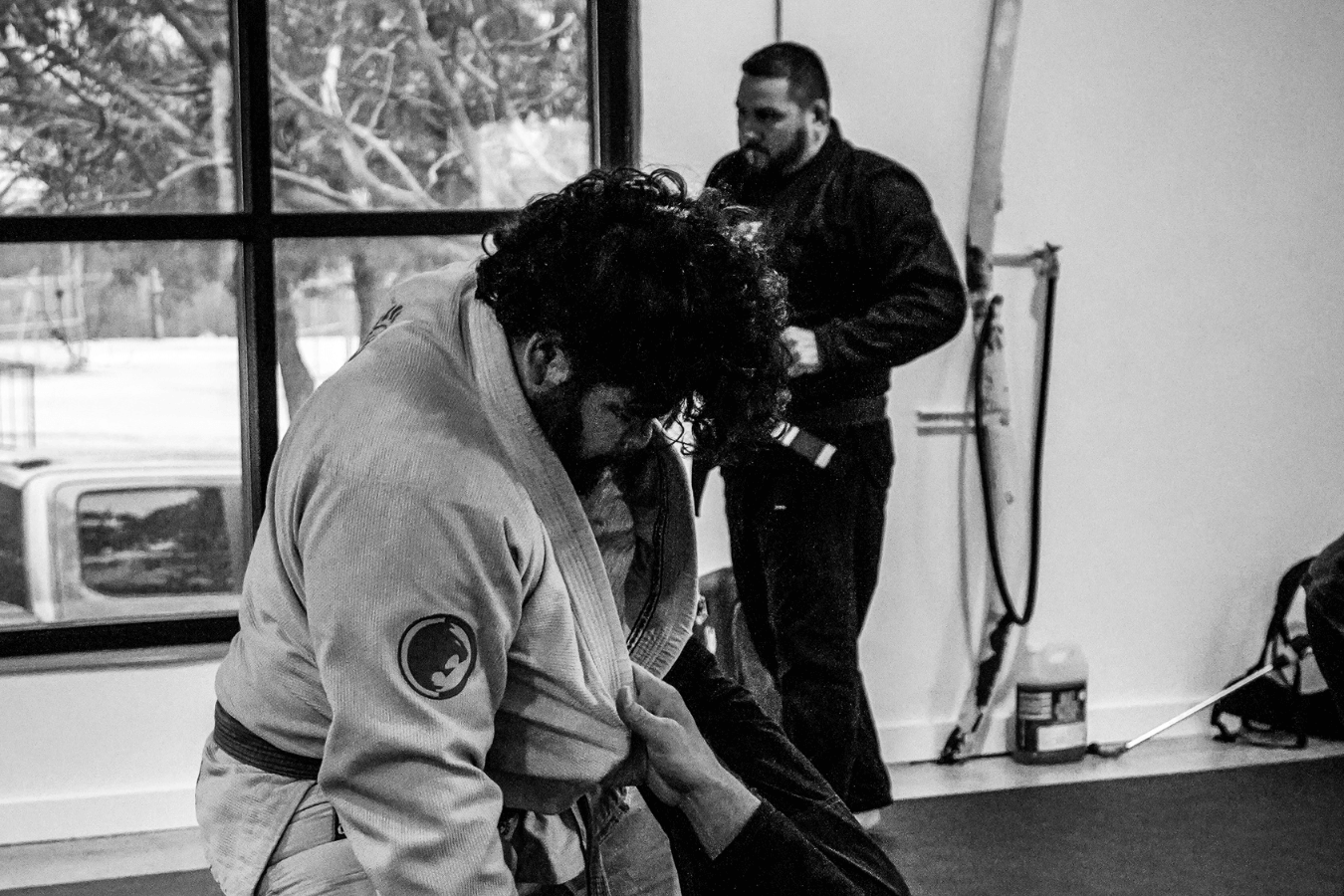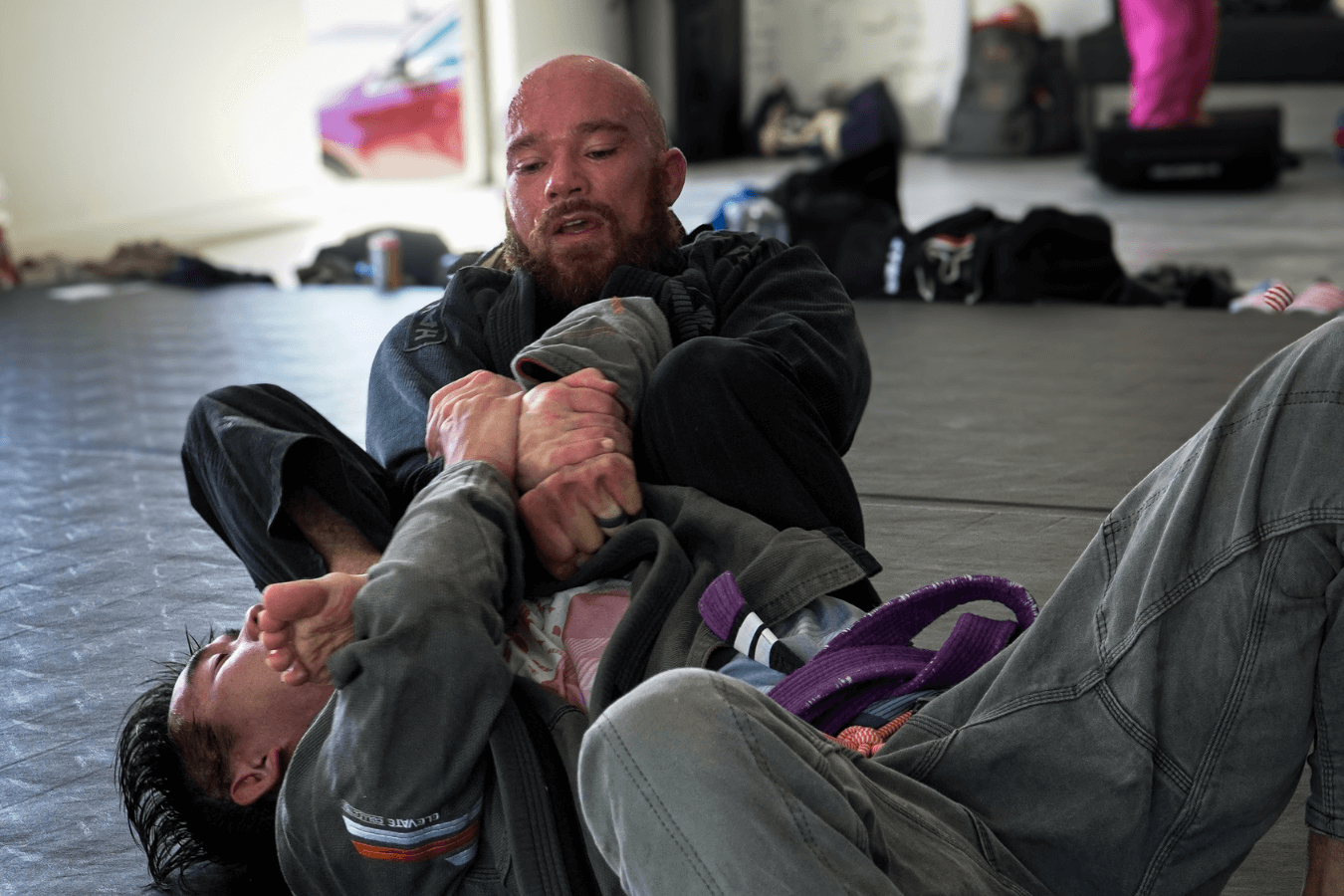
athlon jiu-jitsu
MARTIAL ARTS FOR ALL LEVELS!

THE ATHLON JIU-JITSU BLOG

April 5, 2025
The triangle choke is one of the most effective and iconic submissions in Brazilian Jiu-Jitsu (BJJ). Whether you're training for self-defense, fitness, or competition, developing a killer triangle choke can significantly improve your ground game. In this guide, we'll break down the mechanics, setups, and troubleshooting tips to help you refine this submission. What Makes the Triangle Choke So Effective? The triangle choke is a powerful submission because it leverages your legs—the strongest part of your body—to isolate and apply pressure to your opponent’s neck. This technique works by using your legs to create a triangle shape, trapping one of your opponent’s arms inside while the other is left out. This setup cuts off blood flow to the brain, leading to a rapid and effective submission. Benefits of Mastering the Triangle Choke High-Percentage Submission – Effective at all levels, from beginners to black belts. Versatile Setup – Can be executed from guard, mount, side control, and scrambles. Self-Defense Application – Useful in real-world scenarios where striking isn't an option. Builds Lower Body Strength – Engages core and leg muscles, improving overall fitness. Step-by-Step Guide to the Perfect Triangle Choke Step 1: Setting Up the Triangle Control the Posture – Use your grips to break your opponent’s posture before attempting the setup. Shoot One Leg Over the Shoulder – Move one leg over their shoulder while controlling their head. Secure the Arm Inside – Push one arm across their chest while keeping the other outside. Lock the Initial Triangle Position – Cross your ankles to maintain control before adjusting. Step 2: Locking It Tight Adjust Your Angle – Pivot your body slightly to create the optimal choking angle. Close the Triangle – Slide your foot under the opposite knee to form a tight lock. Squeeze Your Knees Together – Engage your adductors to increase pressure. Pull the Head Down – This enhances the choking effect, forcing a faster tap. Step 3: Finishing the Triangle Eliminate Gaps – Any space reduces pressure, so keep everything tight. Flex Your Feet – This ensures proper positioning and prevents counters. Adjust the Angle Further – Sometimes, a small hip shift is needed for maximum pressure. Hold Until the Tap – Maintain control, but be ready to release once your opponent taps. Common Mistakes and How to Fix Them Mistake 1: Leaving Too Much Space Fix: Keep your knees squeezed tightly together to eliminate gaps. Mistake 2: Poor Angle Fix: Rotate slightly to the side for better leverage. Mistake 3: Weak Leg Control Fix: Engage your leg muscles fully and flex your feet. Mistake 4: Not Controlling the Head Fix: Keep downward pressure on the head for maximum effect. Triangle Choke Setups for Different Situations Triangle from Closed Guard Break their posture with a strong collar grip. Push one arm through and shoot your legs up. Lock the triangle and finish as described above. Triangle from Mount When the opponent pushes up, slide a leg under their arm. Roll to your back and lock the triangle. Adjust your angle and finish. Triangle from Side Control Transition by stepping over their head and securing the arm. Rotate to adjust and lock the choke. Maintain pressure until the tap. Frequently Asked Questions (FAQ) How long does it take to develop a strong triangle choke? With consistent training, most students can start effectively applying the triangle choke within a few months. Mastery takes time, but refining details will make it much stronger. Can I finish the triangle choke if my opponent is larger than me? Yes! Proper mechanics and leverage are more important than size. Focus on angles and leg control. What should I do if my opponent defends by stacking me? Use your hands to create frames and adjust your angle to prevent the stack. If needed, transition to an armbar. Conclusion The triangle choke is a must-have submission in your BJJ arsenal. By mastering the setup, mechanics, and finishing details, you can develop a highly effective and reliable submission. Whether you're training for self-defense, fitness, or competition, refining your triangle choke will elevate your ground game. Call to Action Ready to take your Brazilian Jiu-Jitsu to the next level? Book your free trial class at Athlon Jiu-Jitsu in San Antonio, TX today and start sharpening your skills!

April 5, 2025
Brazilian Jiu-Jitsu (BJJ) is known for its powerful submission techniques, allowing smaller individuals to overcome larger opponents with skill and leverage. Whether you're new to BJJ or looking to refine your game, mastering submissions is essential. In this guide, we’ll break down the most common and effective submission techniques used in BJJ. The Importance of Learning Submissions in BJJ Control and Strategy – Submissions allow you to control an opponent and force a decisive end to a match. Self-Defense – In real-world situations, knowing submissions can help you neutralize threats without excessive force. Competition Readiness – Submissions are a key component of sport BJJ and are necessary for success in tournaments. Essential Submission Techniques in Brazilian Jiu-Jitsu 1. Triangle Choke The triangle choke is a powerful submission that uses the legs to cut off blood flow to the brain. How to Execute: Trap your opponent’s head and arm between your legs. Lock your ankles in a figure-four position. Squeeze your thighs while pulling down on their head. 2. Armbar The armbar is a fundamental submission that hyperextends the elbow joint. How to Execute: Secure your opponent’s arm by controlling their wrist. Swing your legs into position, placing one across their chest and the other over their head. Extend your hips while keeping their arm isolated. 3. Rear Naked Choke (RNC) The RNC is one of the most effective chokes in BJJ, attacking the carotid arteries. How to Execute: Secure back control and place one arm under your opponent’s chin. Lock your biceps with your other arm. Squeeze to cut off blood flow and force a tap. 4. Kimura Lock The Kimura targets the shoulder joint and is effective from multiple positions. How to Execute: Secure a two-on-one grip on your opponent’s wrist. Step over and rotate their arm behind their back. Apply pressure to force a submission. 5. Guillotine Choke A great submission for catching an opponent during a takedown attempt. How to Execute: Wrap your arm around your opponent’s neck. Lock in a tight grip and apply upward pressure. Squeeze and engage your core to complete the choke. Common Questions About BJJ Submissions Are Submissions Safe for Beginners? Yes! With proper instruction and controlled training, BJJ submissions are safe and effective. Learning to tap early is crucial for injury prevention. How Long Does It Take to Master Submissions? Progress varies, but consistent training over months and years will refine your technique. Partnering with experienced instructors accelerates learning. Can Smaller Practitioners Effectively Use Submissions? Absolutely! BJJ is designed for smaller individuals to overcome strength disadvantages through leverage and technique. Conclusion Mastering submissions in BJJ is a journey that enhances your self-defense skills, competition readiness, and overall understanding of the art. At Athlon Jiu-Jitsu , we provide expert instruction to help you improve faster. Ready to take your BJJ skills to the next level? Book your free trial today and start mastering these game-changing submissions!

April 5, 2025
Getting stuck in a bad position in Brazilian Jiu-Jitsu can be frustrating and exhausting. Whether you’re trapped in side control, mounted, or caught in a submission, knowing how to escape efficiently can make all the difference. Developing strong escape techniques not only enhances your defense but also builds confidence and improves overall performance. In this guide, we'll break down essential escapes and strategies to help you stay safe and regain control. Understanding the Importance of Escapes Escapes are a fundamental part of Brazilian Jiu-Jitsu. They allow practitioners to: Avoid submissions – Escaping bad positions reduces the risk of getting submitted. Conserve energy – Effective escapes require technique over brute strength. Regain control – A successful escape transitions you to a dominant or neutral position. Boost confidence – The ability to escape gives practitioners peace of mind when rolling. Essential Escape Techniques Escaping Side Control Side control is a dominant position for your opponent, but with the right approach, you can escape effectively. Bridge and Shrimp Frame – Use your arms to create space against your opponent’s shoulder and hip. Bridge – Drive your hips upward to unbalance your opponent. Shrimp – Slide your hips out to create distance. Recover guard or turtle – Once you create space, reposition yourself. Underhook Escape Get an underhook – Use your near arm to reach under your opponent’s armpit. Turn to your side – This makes it harder for your opponent to apply pressure. Come to your knees – Work your way up to a neutral position. Escaping Mount Being mounted is one of the worst positions, but escapes are possible with proper technique. Bridge and Roll Trap an arm and leg – Isolate one side by controlling your opponent’s wrist and foot. Bridge explosively – Use your hips to lift your opponent. Roll over – Redirect their weight and land in their guard. Elbow Escape Frame against their knee – Use your forearm to create space. Shrimp out – Move your hips while sliding a knee through. Recover guard – Continue moving until you can establish a defensive position. Escaping Back Control Back control is one of the most dangerous positions, but there are ways to escape. Hand Fight and Turn Control their hands – Prevent the choke by stripping grips. Turn to the choking side – Move toward the arm that is attacking your neck. Drop your shoulders – Slip down and turn into your opponent’s guard. Hip Escape Bridge – Create movement by shifting your weight. Shrimp to the mat – Slide your hips downward. Turn into guard – Establish a safer position. Drills to Improve Your Escapes Positional sparring – Start in a bad position and work exclusively on escapes. Solo bridging and shrimping – Build muscle memory for movement efficiency. Frame and movement drills – Focus on creating space against resistance. Rolling with higher belts – Experience resistance and refine techniques. Common Mistakes to Avoid Relying on strength – Technique should always take priority over power. Panic movements – Stay calm and think strategically. Ignoring frames – Proper framing prevents opponents from settling their weight. Forgetting to anticipate – Read your opponent’s movements and react accordingly. FAQs How long does it take to get good at escapes? Improving your escapes depends on consistency. Practicing specific drills and applying them in sparring will accelerate your progress. Should I focus on escapes as a beginner? Absolutely! Developing solid escapes early in your training builds confidence and prepares you for more advanced techniques. Are there any specific workouts to improve escape ability? Yes, core and hip mobility exercises, such as bridges, shrimps, and sprawls, can enhance your escape performance. Conclusion Mastering escape techniques in Brazilian Jiu-Jitsu is crucial for every practitioner. By drilling proper movements, avoiding common mistakes, and maintaining a calm mindset, you can significantly improve your ability to regain control in difficult situations. Ready to take your BJJ skills to the next level? Book your free trial today at Athlon Jiu-Jitsu in San Antonio, TX!

April 5, 2025
Brazilian Jiu-Jitsu (BJJ) is well-known for its ground game, but mastering takedowns is just as crucial. Whether you’re training for self-defense, fitness, or competition, understanding how to take an opponent to the ground efficiently gives you a huge advantage. In this guide, we’ll cover the best BJJ takedown techniques, focusing on practical applications for beginners and experienced practitioners alike. Why Takedowns Matter in BJJ Control the Fight : The one who dictates where the fight takes place holds the advantage. Improve Self-Defense : Many street confrontations start standing. Knowing how to take an opponent down safely is invaluable. Better Competition Performance : Many BJJ tournaments reward points for takedowns, giving you an early lead. Enhance Overall Skills : Integrating stand-up techniques into your BJJ game makes you a more complete martial artist. Best BJJ Takedown Techniques 1. Single-Leg Takedown One of the most effective and commonly used takedowns in BJJ, the single-leg takedown works well in both gi and no-gi settings. How to Execute: Set up : Use hand-fighting to get close, then level change. Grip : Grab one leg (around the knee or ankle). Drive : Pull their leg toward you while stepping in and driving them off balance. Finish : Transition to a trip or run the pipe to bring them down. 2. Double-Leg Takedown The double-leg takedown is a staple in wrestling and highly effective in BJJ, especially in no-gi training. How to Execute: Set up : Use a feint or hand-fighting to create an opening. Shoot in : Level change and penetrate deeply into your opponent’s base. Grip and Drive : Wrap your arms around both legs and drive forward. Finish : Lift and slam or turn the corner to off-balance them. 3. Osoto Gari (Major Outer Reap) This classic judo throw is powerful and useful in gi-based BJJ. How to Execute: Grip : Secure a collar and sleeve grip. Step and Reap : Step outside your opponent’s leg and sweep their leg with force. Use Upper Body : Pull them forward to break their balance while sweeping. Land in Control : Secure a dominant position upon landing. 4. Tomoe Nage (Sacrifice Throw) A high-risk, high-reward takedown, the tomoe nage is excellent for turning an opponent’s aggression into your advantage. How to Execute: Grip : Grab the collar and sleeve. Drop Back : Sit while placing one foot on their hip. Kick and Roll : Extend your leg to launch them overhead while rolling into a dominant position. 5. Foot Sweeps Foot sweeps are subtle but effective for setting up takedowns with minimal energy. How to Execute: Control the Upper Body : Use grips to off-balance your opponent. Sweep Timing : As they shift weight, sweep the foot they’re about to step with. Follow Up : Secure a dominant position immediately. Training Tips for Better Takedowns Drill with Purpose : Repetition is key to mastering takedowns. Focus on Timing : Learn to recognize when your opponent is off-balance. Work on Entries : Setting up a takedown is just as important as finishing it. Use Resistance Training : Strength and endurance help improve your shots. Common Questions About BJJ Takedowns Do I need wrestling experience for BJJ takedowns? No, but wrestling skills can help. Many effective BJJ takedowns come from judo and wrestling, so cross-training is beneficial. What’s the safest takedown for beginners? The single-leg takedown is a great starting point because it requires minimal risk and is easy to learn. Are takedowns necessary for self-defense? Yes! Controlling where the fight goes is crucial, and takedowns help neutralize an opponent effectively. Conclusion Mastering takedowns in BJJ enhances your game, making you a more well-rounded practitioner. Whether you're training for self-defense, competition, or fitness, learning how to take an opponent down effectively will give you an edge. Ready to sharpen your takedown skills? Book your free trial today at Athlon Jiu-Jitsu in San Antonio, TX!
Request Information
Get started today!
ACCESS OUR SCHEDULE
& EXCLUSIVE WEB SPECIAL
© 2025
All Rights Reserved | Brava Holdings Inc.

